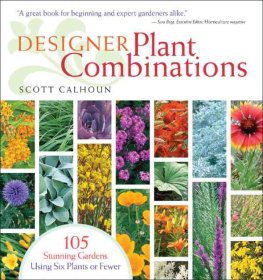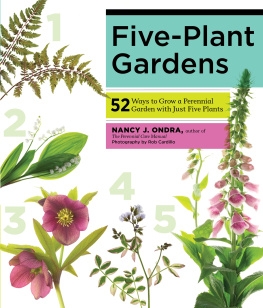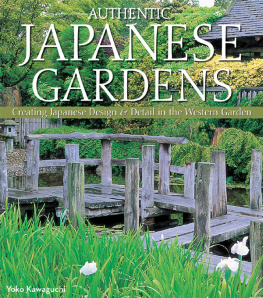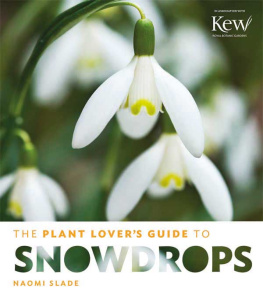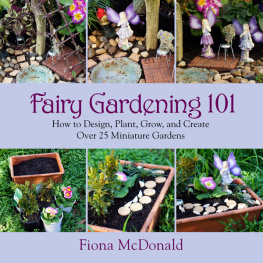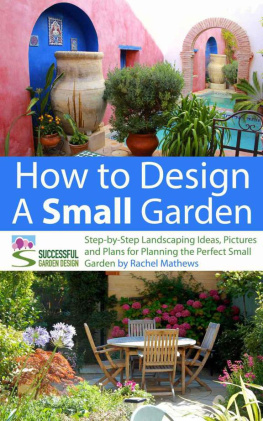
Designer Plant Combinations
105 Stunning Gardens Using Six Plants or Fewer

SCOTT CALHOUN

The mission of Storey Publishing is to serve our customers by
publishing practical information that encourages
personal independence in harmony with the environment.
Edited by Carleen Madigan Perkins
Art direction and book design by Mary Winkelman Velgos
Front cover photography by Scott Calhoun: columns 1 top, 2, 3, 5, 7 and Charles Mann: columns 1 middle, bottom, 4, 6
Back cover photography by Charles Mann, except author photo by Edward McCain
Interior photography by Scott Calhoun, except for Marion Brenner: 7475; Karen Bussolini: 130131, 137, 166167, 180181, 184185; Rob Cardillo: 6, 3031, 65, 199, 214215, 220221; Saxon Holt: 118119, 152-153, 210211, 224225; Charles Mann: 23, 9, 10, 13, 18-19, 2021, 2223, 26-27, 34-35, 4445, 4849, 50, 6263, 7879, 8687, 91, 107, 128129, 132133, 177, 190191; Carrie Nimmer, Landscape Designer: 165, 172173
Indexed by Christine Lindemer, Boston Road Communications
Text 2008 by Scott Calhoun
All rights reserved. No part of this book may be reproduced without written permission from the publisher, except by a reviewer who may quote brief passages or reproduce illustrations in a review with appropriate credits; nor may any part of this book be reproduced, stored in a retrieval system, or transmitted in any form or by any means electronic, mechanical, photocopying, recording, or other without written permission from the publisher.
The information in this book is true and complete to the best of our knowledge. All recommendations are made without guarantee on the part of the author or Storey Publishing. The author and publisher disclaim any liability in connection with the use of this information. For additional information, please contact Storey Publishing, 210 MASS MoCA Way, North Adams, MA 01247.
Storey books are available for special premium and promotional uses and for customized editions. For further information, please call 1-800-793-9396.
Printed in China by R.R. Donnelley
10 9 8 7 6 5 4 3 2 1
Library of Congress Cataloging-in-Publication Data
Calhoun, Scott.
Designer plant combinations / by Scott Calhoun.
p. cm.
Includes index.
ISBN 978-1-60342-077-8 (pbk. : alk. paper)
1. GardeningUnited States.
2. GardensUnited StatesDesign.
3. Plants, OrnamentalSelectionUnited States. I. Title.
SB451.3.C35 2008
712.60973dc22
2008022439
People sometimes think that gardening and plants are somehow trivial pursuits, mere pastimes, hobbies, somehow irrelevant. Nothing could be further from the truth. Gardening is the most powerful sacrament that links mankind to the natural world. Only twelve thousand years ago humanity began to grow plants deliberately. Those first acts of gardening catapulted a million years worth of hunting-gathering into the vertiginous explosion of higher civilization. Each time you put a trowel in the fragrant earth, you recapitulate that bold and terrible act.
Panayoti Kelaidis
Acknowledgments
My most sincere thanks go out to the following, who graciously shared their time, gardens, and insights with me: Dan Benarcik at Chanticleer; Duncan Brine; Dave Buchanan; Karen Bussolini; Gloria Ciaccio at Chicago Botanic Garden; Stephanie Cohen; David Cristiani; Sharon Cybart at Olbrich Gardens; Neil Diboll; Janet Draper at the Smithsonian; Noel Gieleghem; Mary Lou Gross; Panayoti Kelaidis; Greg Foreman; Inta Krombolz; Longwood Gardens staff; Lynden B. Miller; Carrie Nimmer; Nancy Ondra; Piet Ouldolf; Judith Phillips; Scott Rothenberger; David Salman; Julie Siegel; Scott Spencer; Nan Sterman; Bill Thomas at Chanticleer; Marcia Tatroe; Brandon Tyson; Laurel Voran at Chanticleer; Lenny Wilson at Delaware Center for Horticulture; Jonathan Wright at Chanticleer.
Following spread: The drumstick flower heads of Purple Sensation ornamental onion (Allium aflatuense Purple Sensation) stand at attention above the maroon leaves of Husker Red penstemon (Penstemon digitalis Husker Red) in this planting at Chanticleer.







INTRODUCTION
There has been a lot of talk about new trends in American gardening over the past few years, very little of which has had to do with plants. If youve spent any time at all surfing the yard-makeover shows on cable television, you might have noticed that plants are often talked about as stage props and window dressing for a patio, spa, or deck. The conventional wisdom suggests that with shrinking lot sizes and growing decks and patios, plants are on their way to being elbowed out of the garden by outdoor living spaces. As Piet Oudolf and Noel Kingsbury point out in their book, Planting Design, garden design has become too much like interior design applied to the out-of-doors, with a focus on overnight transformation rather than the craft of growing and nurturing plants. This sort of put them behind the Jacuzzi mentality about plants got me wondering exactly how much plants or rather the thoughtful arrangement of plants in gardens matter anymore.
In my own garden design practice, I believe that plants matter a lot. I got into this business to work with roots and shoots rather than simply promoting the masonry trade. When I started this book, I suspected that other garden designers felt the same way. To find out, I traveled across the country photographing the work of designers and horticulturists and tapped a vein of plant passion that far exceeded my expectations. It turns out that plants do still matter, maybe more than ever. They are the raw material for the artists we call landscape designers.
The diversity of the plant combinations I found was endless and the creativity of my fellow designers and horticulturists energized my hunt. I found designers using plants like painters and sculptors, shoehorning amazing collections into small urban lots, and bringing prairie plantings to the suburbs with gusto. Native plants were making their way into sophisticated city settings. I saw color put to fearless use a monochromatic garden of gold and yellow plants and a scene of spiky succulents profiled against a pomegranate-colored wall. In choosing these garden vignettes, I focused on innovative ensembles with a sense of intention and purpose that could be called the designer touch.
Next page
